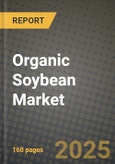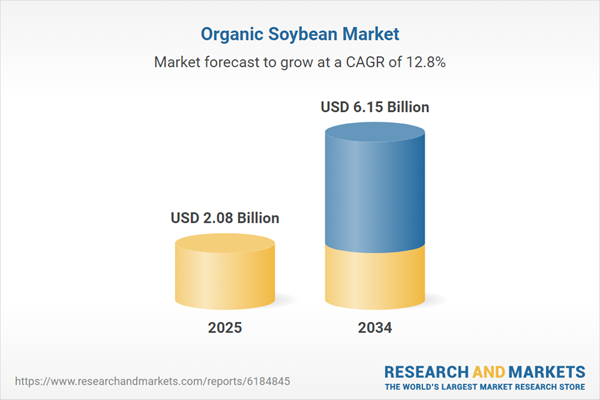Organic Soybean Market
The Organic Soybean market spans whole beans, food-grade identities, soybean meal, soybean oil, soy protein concentrates/isolates, tofu/tempeh bases, soy beverages, and specialty fractions such as lecithin and fiber. Core end-uses include human nutrition (tofu, beverages, meat analogs, bakery, infant/clinical, Asian foods), premium animal feed for dairy/poultry/swine, specialty aquaculture diets, and nutraceuticals/personal care via oil/lecithin. Trends emphasize identity-preserved (IP) supply chains, regenerative farming practices, non-GMO verification, and clean-label proteins powering plant-forward foods. Demand is propelled by flexitarian diets, retailer scorecards favoring organic and deforestation-free claims, and food brands pivoting to transparent ingredients with traceable origins. The competitive landscape blends farmer-owned co-ops, IP aggregators, crushers/refiners, protein processors, and brand-owned sourcing programs; differentiation rests on varietal selection and protein functionality, amino acid balance for feed, hexane-free oil extraction, and audit-ready documentation. Execution priorities include segregated logistics from farm to processing, strict allergen and foreign-material controls, moisture/activity management in storage, and contracts that align planting to downstream promotions. Key challenges include weather-driven yield variability, weed/insect pressure without synthetic chemistry, organic certification costs, freight/port congestion, and competition from other plant proteins. As plant-based foods mature, buyers increasingly require consistent sensory, rapid rehydration, and low off-notes in proteins, while feed buyers demand predictable digestibility and anti-nutritional factor management. Overall, organic soybean supply chains are professionalizing with data-rich traceability, long-term grower contracts, and sustainability metrics embedded in procurement.Organic Soybean Market Key Insights
- Identity preservation is the market’s passport to value. From seed selection to containerization, IP protocols (varietal purity, moisture, FM specs) protect food-grade premiums. On-farm cleaning, dedicated bins, and sealed transport reduce downgrades. Processors reward growers for protein, color, and beany-note mitigation. Blockchain/portal traceability speeds retailer audits and strengthens brand stories. Year-round VMI and safety stocks cushion promotions and new product launches.
- Agronomy underpins reliable organic yields. Rotations with small grains/legumes, cover crops, and biologicals manage weeds and fix nitrogen. Mechanical cultivation, stale seedbeds, and precision row widths reduce herbicide needs while protecting soil. Seed treatments approved for organic improve stand vigor. Field-level scouting and pest thresholds drive timely interventions. Grower coaching and peer networks raise average field performance over time.
- Food-grade beans demand sensory-led specs. Varieties screened for low lipoxygenase activity and lighter hilum color reduce beany notes and pigment carry-through in tofu/soymilk. Soak/cook profiles and protein solubility dictate curd firmness and beverage mouthfeel. Hexane-free or aqueous extraction preserves label simplicity. Deodorization and enzyme steps refine flavor without harsh processing, supporting premium SKUs.
- Protein functionality wins listings in alt-protein. Solubility, emulsification, and gelation at target pH/ionic strengths drive texture in meat analogs and beverages. Particle size and RVA/NSI control rehydration speed and smoothness. Enzyme-enabled or mildly fermented soy proteins improve flavor and digestibility. Co-formulation with oat/pea balances amino acids and sensory, expanding recipe latitude across formats.
- Feed buyers prioritize digestibility and consistency. Organic soybean meal must deliver reliable amino acid profiles and manageable trypsin inhibitor levels. Toast/heat profiles and proper cool-down prevent over- or under-processing. Diet formulators demand tight ash/fiber specs and microbiology control. Contracts synchronized to lactation or grow-out cycles stabilize mill operations and performance.
- Oil and lecithin add multipurpose value. Cold-pressed or expeller oils fit premium culinary and personal-care niches; deodorized oils support infant/clinical adjacencies with strict impurity controls. Organic lecithin enables clean emulsification in chocolate, bakery, and beverage systems. Documentation on allergens, solvents, and pesticides is a gatekeeper for multinational accounts. Packaging and light/oxygen barriers protect stability.
- Regulatory and certification discipline is non-negotiable. Harmonizing organic, non-GMO, allergen, and country-specific import rules prevents demurrage and relabeling. Change-control, residue testing, and audit trails streamline retailer onboarding. Halal/kosher and baby-food compliance broaden addressable markets. Transparent corrective actions on non-conformances preserve listings and trust.
- Sustainability metrics move from narrative to KPIs. Soil organic matter, water stewardship, biodiversity, and low-carbon logistics are increasingly requested in RFPs. Verified deforestation-free and regenerative practices improve shelf placement and qualify for corporate ESG targets. Grower premiums tied to documented outcomes accelerate adoption. Clear, third-party verified claims deter greenwashing risk.
- Risk management separates resilient suppliers. Weather, freight, and currency swings demand multi-origin contracting, forward cover, and flexible shipping (bulk/container). On-farm drying and aeration protect quality in humid harvests. Substitution matrices (variety-to-variety, protein lot blending) maintain spec while avoiding reformulation. Robust recall readiness and dual-qualified plants ensure continuity.
- Route-to-market and service create stickiness. Crop contracting with agronomy support secures volume. Application labs translate protein/meal specs into finished product outcomes. Bilingual QA, rapid COA/COC portals, and small-lot sampling accelerate NPD. Vendor-managed inventory and postponement packaging meet omnichannel needs without inflating working capital.
Organic Soybean Market Reginal Analysis
North America
A leading origin for food-grade and feed-grade organic beans with mature IP programs and farmer co-ops. Strong demand from tofu, beverage, and plant-based brands, plus organic dairies and poultry. Buyers emphasize long-term grower contracts, rail/container reliability, and rigorous allergen controls. Sustainability scorecards and regenerative practices gain procurement weight. Regional crush and protein capacity support faster lead times.Europe
High organic penetration in retail with strict traceability and import compliance. Food-grade beans power tofu, beverages, bakery, and baby foods; meal supports organic poultry/dairy. Preference for hexane-free oils and lecithin in clean-label categories. Documentation depth, deforestation-free assurances, and non-GMO verification are essential. Logistics favor reliable container lanes and regional packaging/processing hubs.Asia-Pacific
Demand led by tofu/tempeh heritage markets and fast-growing plant-based segments in urban centers. Japan and parts of Southeast Asia prioritize premium sensory and small-lot IP; Australia/New Zealand emphasize regenerative credentials. Humidity-resilient storage, rapid port clearance, and bilingual QA are critical. Local processing and private-label growth accelerate turnaround for retailers and QSR suppliers.Middle East & Africa
Growing modern trade and foodservice adopt organic soy beverages, bakery, and meat alternatives in major cities. Import-reliant markets require consistent specs, halal documentation, and heat-resilient packaging. Organic feed demand increases with premium poultry/dairy niches. Distributors with cold/dry chain capability and technical support capture share; education on allergen handling reduces risk.South & Central America
Expanding organic acreage and export programs alongside developing local consumption of beverages, bakery, and plant-based meals. Buyers seek robust IP and contamination control during transport. Currency/logistics volatility favors local processing and flexible contracts. ESG narratives around soil and biodiversity resonate with exporters to premium markets; meal supports organic poultry/dairy clusters.Organic Soybean Market Segmentation
By Type
- Fresh
- Dry
By Application
- Food and Beverage
- Personal Care and Cosmetics
- Pharmaceutical
- Animal Feed and Pet Food
- Others
Key Market players
Clarkson Grain Company, Sunrise Foods International, Tradin Organic (Acomo), Nature Bio Foods (LT Foods), Scoular, Perdue AgriBusiness, DO-IT Dutch Organic International Trade, American Natural Processors (ANP), Zeeland Farm Services (ZFS), Healthy Food Ingredients (HFI), Cereal Docks (Nateeo), Beidahuang Group / Jiusan, ETG (Export Trading Group), Agrocorp International, Grain Millers, Inc.Organic Soybean Market Analytics
The report employs rigorous tools, including Porter’s Five Forces, value chain mapping, and scenario-based modelling, to assess supply-demand dynamics. Cross-sector influences from parent, derived, and substitute markets are evaluated to identify risks and opportunities. Trade and pricing analytics provide an up-to-date view of international flows, including leading exporters, importers, and regional price trends.Macroeconomic indicators, policy frameworks such as carbon pricing and energy security strategies, and evolving consumer behaviour are considered in forecasting scenarios. Recent deal flows, partnerships, and technology innovations are incorporated to assess their impact on future market performance.
Organic Soybean Market Competitive Intelligence
The competitive landscape is mapped through proprietary frameworks, profiling leading companies with details on business models, product portfolios, financial performance, and strategic initiatives. Key developments such as mergers & acquisitions, technology collaborations, investment inflows, and regional expansions are analyzed for their competitive impact. The report also identifies emerging players and innovative startups contributing to market disruption.Regional insights highlight the most promising investment destinations, regulatory landscapes, and evolving partnerships across energy and industrial corridors.
Countries Covered
- North America - Organic Soybean market data and outlook to 2034
- United States
- Canada
- Mexico
- Europe - Organic Soybean market data and outlook to 2034
- Germany
- United Kingdom
- France
- Italy
- Spain
- BeNeLux
- Russia
- Sweden
- Asia-Pacific - Organic Soybean market data and outlook to 2034
- China
- Japan
- India
- South Korea
- Australia
- Indonesia
- Malaysia
- Vietnam
- Middle East and Africa - Organic Soybean market data and outlook to 2034
- Saudi Arabia
- South Africa
- Iran
- UAE
- Egypt
- South and Central America - Organic Soybean market data and outlook to 2034
- Brazil
- Argentina
- Chile
- Peru
Research Methodology
This study combines primary inputs from industry experts across the Organic Soybean value chain with secondary data from associations, government publications, trade databases, and company disclosures. Proprietary modeling techniques, including data triangulation, statistical correlation, and scenario planning, are applied to deliver reliable market sizing and forecasting.Key Questions Addressed
- What is the current and forecast market size of the Organic Soybean industry at global, regional, and country levels?
- Which types, applications, and technologies present the highest growth potential?
- How are supply chains adapting to geopolitical and economic shocks?
- What role do policy frameworks, trade flows, and sustainability targets play in shaping demand?
- Who are the leading players, and how are their strategies evolving in the face of global uncertainty?
- Which regional “hotspots” and customer segments will outpace the market, and what go-to-market and partnership models best support entry and expansion?
- Where are the most investable opportunities - across technology roadmaps, sustainability-linked innovation, and M&A - and what is the best segment to invest over the next 3-5 years?
Your Key Takeaways from the Organic Soybean Market Report
- Global Organic Soybean market size and growth projections (CAGR), 2024-2034
- Impact of Russia-Ukraine, Israel-Palestine, and Hamas conflicts on Organic Soybean trade, costs, and supply chains
- Organic Soybean market size, share, and outlook across 5 regions and 27 countries, 2023-2034
- Organic Soybean market size, CAGR, and market share of key products, applications, and end-user verticals, 2023-2034
- Short- and long-term Organic Soybean market trends, drivers, restraints, and opportunities
- Porter’s Five Forces analysis, technological developments, and Organic Soybean supply chain analysis
- Organic Soybean trade analysis, Organic Soybean market price analysis, and Organic Soybean supply/demand dynamics
- Profiles of 5 leading companies - overview, key strategies, financials, and products
- Latest Organic Soybean market news and developments
Additional Support
With the purchase of this report, you will receive:- An updated PDF report and an MS Excel data workbook containing all market tables and figures for easy analysis.
- 7-day post-sale analyst support for clarifications and in-scope supplementary data, ensuring the deliverable aligns precisely with your requirements.
- Complimentary report update to incorporate the latest available data and the impact of recent market developments.
This product will be delivered within 1-3 business days.
Table of Contents
Companies Mentioned
- Clarkson Grain Company
- Sunrise Foods International
- Tradin Organic (Acomo)
- Nature Bio Foods (LT Foods)
- Scoular
- Perdue AgriBusiness
- DO-IT Dutch Organic International Trade
- American Natural Processors (ANP)
- Zeeland Farm Services (ZFS)
- Healthy Food Ingredients (HFI)
- Cereal Docks (Nateeo)
- Beidahuang Group / Jiusan
- ETG (Export Trading Group)
- Agrocorp International
- Grain Millers Inc.
Table Information
| Report Attribute | Details |
|---|---|
| No. of Pages | 160 |
| Published | November 2025 |
| Forecast Period | 2025 - 2034 |
| Estimated Market Value ( USD | $ 2.08 Billion |
| Forecasted Market Value ( USD | $ 6.15 Billion |
| Compound Annual Growth Rate | 12.8% |
| Regions Covered | Global |
| No. of Companies Mentioned | 15 |









